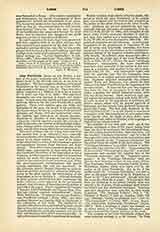

Liberatus of Carthage (sixth century), archdeacon, author of an important history of the Nestorian and Monophysite troubles. In 535 he was sent to Rome, as legate of a great African national synod of two hundred and seventeen bishops, to consult Pope Agapetus I (535-6) about a number of questions (Harduin, II, 1154; Mansi, VIII, 808). Like most Africans he was vehemently opposed to Justinian’s edict against the “Three Chapters” (544). He was frequently employed by the African bishops as their ambassador in the disputes that arose from that question. “Tired with the fatigue of traveling, and resting the mind a little from temporal cares” (introduction to his book), he used his leisure to compose a summary history of the two great heresies of the preceding century. His object in writing it was avowedly to show how misjudged the emperor’s condemnation of the Three Chapters was. The work is called “A Short Account of the Affair of the Nestorians and Eutychians” (Breviarium causae Nestorianorum et Eutychianorum). It begins with the ordination of Nestorius (428) and ends with the Fifth General Council (Constantinople II, 553). From the fact that the author mentions Theodosius of Alexandria as being still alive (xx), it is evident that it was-written before 567, in which year Theodosius died. On the other hand, Liberatus records the death of Pope Vigilius (June, 555). His authorities are the “Historia tripartita” of Cassiodorus, acts of synods, and letters of contemporary Fathers. In spite of Liberatus’s controversial purpose and his indignation against Monophysites and all aiders and abettors of the condemnation of the Three Chapters, his short history is well and fairly written. It forms an important document for the history of the two heresies.
ADRIAN FORTESCUE

